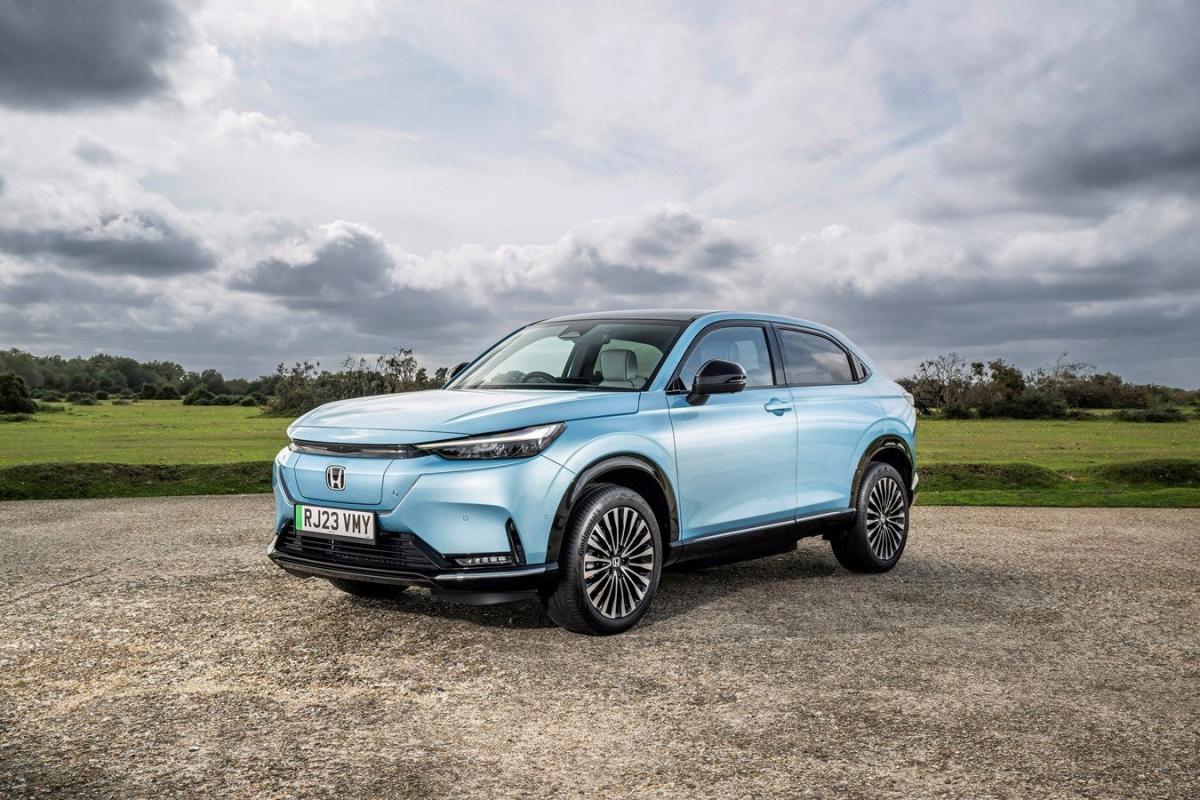What to call an electric version of the C segment HR-V? Perhaps the name which Honda came up with seems on overly complicated and hard to remember badge, but it is what it is. At least the lower case e makes sense and fits with the company system of e:HEV for hybrids and ePHEV for you can guess what.
The looks are not that different to those of the HR-V (which in the UK is hybrid-only) though a large fold-down charging flap in the grille is one of the easiest-to-spot differences.
How far will it go?
The usual question with an EV can be answered thus: a maximum range of 256 miles (WLTP) and a real world average of about 230 during the days I spent with a car. Most of that time I stayed in Economy mode, one of three settings, the others being Sport and Normal
How does it handle?
Selecting Sport makes the car a little bit faster with cornering less floaty so it’s handy to have this option. The steering remains very light though, and the ride tuned to a comfort default – this is not a coupé-SUV, nor is it marketed as one.
Power and performance
A 150 kW (204 PS) and 310 Nm motor powers the front axle of the e:Ny1 and that whisks this SUV to 62 mph in a competitive 7.7 seconds while the top speed is 100 mph.
And charging?
If you use an 11 kW AC connection, charge from 10-80 percent takes about six hours, or only 45 minutes via DC at up to 78 kW. And the battery capacity? That’s 68.8 kWh.
Benefit of a 2.6m+ long wheelbase
For a model which wasn’t expressly designed to be electric-only, this 4.4 m long vehicle is really cleverly packaged and therefore very roomy. At least for all five occupants, though the boot could possibly be bigger if I had to find one thing that some rivals do better. And this says just how heavy most EVs are: the e:Ny1 tips the scales at ’just’ 1,752 kilos.
Bespoke detailing
As mentioned earlier, the exterior appearances of the HR-V and e:Ny1 are similar although Honda has done well to differentiate them. Things such some especially snazzy-looking turbine-pattern wheels on the EV, white for the H logo badges, distinctive trim pieces front and back and even some nicely bright (but not showy) colours set the electric model apart.
Premium interior?
On the inside, the ambience is premium – the brand is becoming ever more like Mazda in this way – with soft surfacing, a thick-rimmed steering wheel and a substantial feel to everything. That includes the push-buttons for automatic ratio selection, beautifully weighted door handles and touchscreen functions which work on the first press. Even the little dials at either end of the dashboard which direct airflow could be from a German OEM of old. Just as importantly, the digital instrument pack ahead of the driver is fairly minimalist and does not constantly nag for your attention.
Pricing
One of the few things you could criticise this electric SUV for is pricing. Or at least it had been. Now, Honda has launched a promotional offer of GBP39,995 or GBP299 a month (with 1.9% APR representative and a GBP 3,000 deposit contribution for qualifying buyers).
The sub-forty thousand number is for the Elegance variant, with the Advance trim level starting at GBP42,195 or GBP339/month. These deals are due to expire on 30 June. The extra money for the higher grade adds features such as a glass roof, heating for the steering wheel, Parking Pilot, a multi-view camera and electric tailgate closing/opening.
Conclusion
Honda UK sold almost 2,000 units of this model in the first quarter with sales rising month after month for about half a year now. With the price cut having kicked in recently, I can see the e:Ny1 defying the general short-term trend of a blip in demand for EVs too. Even people who may not think an electric SUV is for them should try this Honda – it is a convincing package.
Future EVs
The much-admired but not often purchased e is now departed, production having ended in January, leaving the e:Ny1 as Honda Motor Europe’s sole EV. That seems highly unlikely to remain the status quo, plus there are rumours of a renaming to an easier to remember Y1 coming in 2025. There could also be a mild facelift, though this is all speculative for the moment.
Last month Honda revealed a couple of electric concepts at the Beijing motor show, stating also that it would have a range of ten EVs in China by 2027. That, however, includes certain twinned vehicles for the GAC and Dongfeng joint ventures, so in reality, we are talking perhaps three maybe four additional vehicles. How many of those will come to the European region? Quite possibly at least two but again, an official statement about this is awaited.
The latest pair are the just-launched GAC Honda e:NP2, to be followed in June by its near-twin, the Dongfeng Honda. Incidentally, that list of ten models officially includes two cars launched back in 2022, the e:NS1 and e:NP1. Honda noted as recently as April that it would be “striving to make EVs represent 100% of its automobile sales in China by 2035”. Which cleverly leaves some wiggle room should buyers still be keen on IC engines in a decade’s time.
“Why the e:Ny1 is Honda’s EV frontrunner” was originally created and published by Just Auto, a GlobalData owned brand.
The information on this site has been included in good faith for general informational purposes only. It is not intended to amount to advice on which you should rely, and we give no representation, warranty or guarantee, whether express or implied as to its accuracy or completeness. You must obtain professional or specialist advice before taking, or refraining from, any action on the basis of the content on our site.
